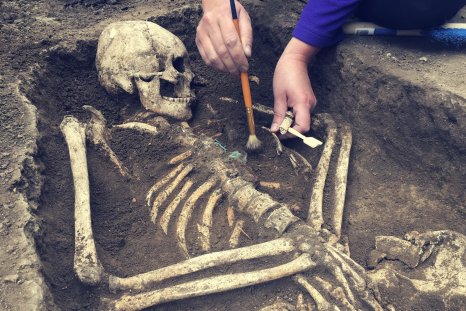A team of archaeologists and conservators has uncovered a spectacular "throne room" in Peru that appears to have been occupied by a powerful female leader.
The pillared room was revealed this summer at the site of Pañamarca in the Nepeña Valley on the country's northern coast, the "Archaeological Landscapes of Pañamarca" research project announced.
Pañamarca is the southernmost monumental center of the Moche culture, a pre-Hispanic society that inhabited the coastal valleys of northern Peru between around A.D. 350 and A.D. 850. This society is renowned for its rich elite tombs, striking architecture and artwork.
Built atop a granite hill in the lower Nepeña Valley, Pañamarca consists of an imposing stepped adobe platform, two lower adobe platforms, a large walled adobe plaza and several other structures. Adobe is a building material made from earth and organic materials.
One of the site's notable features is the colorful wall paintings situated within the plaza and platforms. These paintings depict priests and warriors in processions, battles between supernatural beings and scenes of ceremonial activities, among other works.
However, a "throne room" that seemingly belonged to a queen had never previously been discovered at the site—not to mention anywhere else in ancient Peru—according to the research project.
In July, researchers found an adobe throne surrounded by walls and pillars depicting four different scenes of a powerful woman. In one, the woman is receiving visitors in procession, while in another, she is seated on a throne. She is even depicted in paintings on the interior surfaces of the throne itself.
The woman appears to be associated with the crescent moon, the sea and its creatures, and the arts of spinning and weaving.
The paintings do not clearly indicate whether the powerful woman depicted in the artworks was real or a mythical figure. It is possible the depictions could represent a priestess, goddess or queen.
However, physical evidence from the throne, including the erosion of its back and the recovery of greenstone beads, fine threads and even human hair, indicates that it was occupied by a real person. According to the researchers, all of the available evidence indicates that this individual was a powerful female leader of Pañamarca who lived in the 7th century.
"Pañamarca continues to surprise us not only because of the inexhaustible creativity of its painters, but also because their works are changing our expectations about gender roles in the ancient Moche world," Lisa Trever, an associate professor of pre-Columbian art history and archaeology at Columbia University, said in a press release.
Do you have a tip on a science story that Newsweek should be covering? Do you have a question about archaeology? Let us know via science@newsweek.com.
Disclaimer: The copyright of this article belongs to the original author. Reposting this article is solely for the purpose of information dissemination and does not constitute any investment advice. If there is any infringement, please contact us immediately. We will make corrections or deletions as necessary. Thank you.



